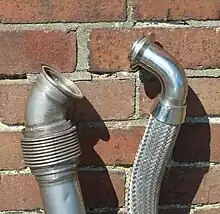Marman clamp
A Marman clamp is a type of heavy-duty band clamp; it allows two cylindrical objects to be clamped together end-to-end with a ring clamp. It is sometimes also known as a "Marman ring". It consists of a circular strap with an interior V-shaped groove. Tension is applied to the strap with a threaded bolt and nuts connecting to the ends of the strap. As the tension increases, the V-groove wedges over flanges on the circular parts to be assembled, providing the force that holds the ends of the two cylinders together. The Marman clamp is an alternative to a bolted flange connection which would be heavier and require more labor to connect. Another variety uses a flat strap, used where systems carry low pressure or to hold a cylindrical object in position.[1]

Hose connectors

A common use for Marman clamps is as quick-disconnect connectors in flexible aircraft fuel lines.[2]
Spacecraft separation
Marman clamps are used extensively in spaceflight systems and are common mechanical load-transfer and clamping mechanisms for connecting the upper stage and the satellite payload of space vehicles,[3][4] for example, on the Cassini Plasma Spectrometer on the Cassini orbiter. They may also be used to join stages of a booster rocket.[3]
Early separation systems using Marman clamps used explosive bolts for release. These have problems of unpredictability, the need to contain debris and difficulties in testing them.[5] A more recent approach uses a screw thread. The tension of the clamp band itself is used to power the unscrewing of a central bolt, when released by a pyrotechnic pin puller triggered by a set of redundant NASA Standard Initiators (NSIs).[6]
History
The Marman clamp was first produced by Herbert Marx, better known by his stage name Zeppo Marx;[2][7] it was manufactured by his company, Marman Products from the 1930s.[8]
At the time it was designed to secure cargo during transport. The U.S. Military used Marman clamps to transport the atomic bombs used at the end of the Second World War.[9]
Marman clamps are found in many modern moving vehicles, though the screw band type clamp is becoming more popular.
See also
References
- http://www.saywell.co.uk/wp-content/uploads/2011/09/TF100-14D_MarmanClampProducts.pdf Marman V-Band Couplings, Flangs, Band Clamps and Strap Assemblies, retrieved Dec 31, 2019
- D’Alto, Nick. "Oldies and Oddities: Zeppo's Gizmo". AIR & SPACE MAGAZINE. Retrieved 11 March 2014.
- "Marman Clamp System Design Guidelines" (PDF). Guideline no. GD-ED-2214. NASA. Archived from the original (PDF) on 2013-02-16. Retrieved 2012-10-20.
- Shoghi, K.; Rao, H. V.; Barrans, Simon (2004). "Stress in V-section band clamps. Proceedings of the Institute of Mechanical Engineering Part C" (PDF). Journal of Mechanical Engineering Science. 3. 218: 251–261. doi:10.1243/095440604322900381. Retrieved 11 March 2014.
- Lazansky, Chuck (2012). "Refinement of a Low-Shock Separation System" (PDF). Proc. of the 41st Aerospace Mechanisms Symposium. Jet Propulsion Laboratory. p. 332. Retrieved 11 March 2014.
- Lazansky 2012, p. 333
- Chandler, Charlotte. Hello, I Must Be Going: Groucho And His Friends, page 182, ISBN 978-1-84739-104-9.
- Trevor Homer Born in the USA: The Book of American Origins,Skyhorse Publishing Inc., 2009 ISBN 1602397112 "Zeppo Marx"
- Donnelly, Jim (August 2009). "Why a Clamp?". Hemmings Classic Car.